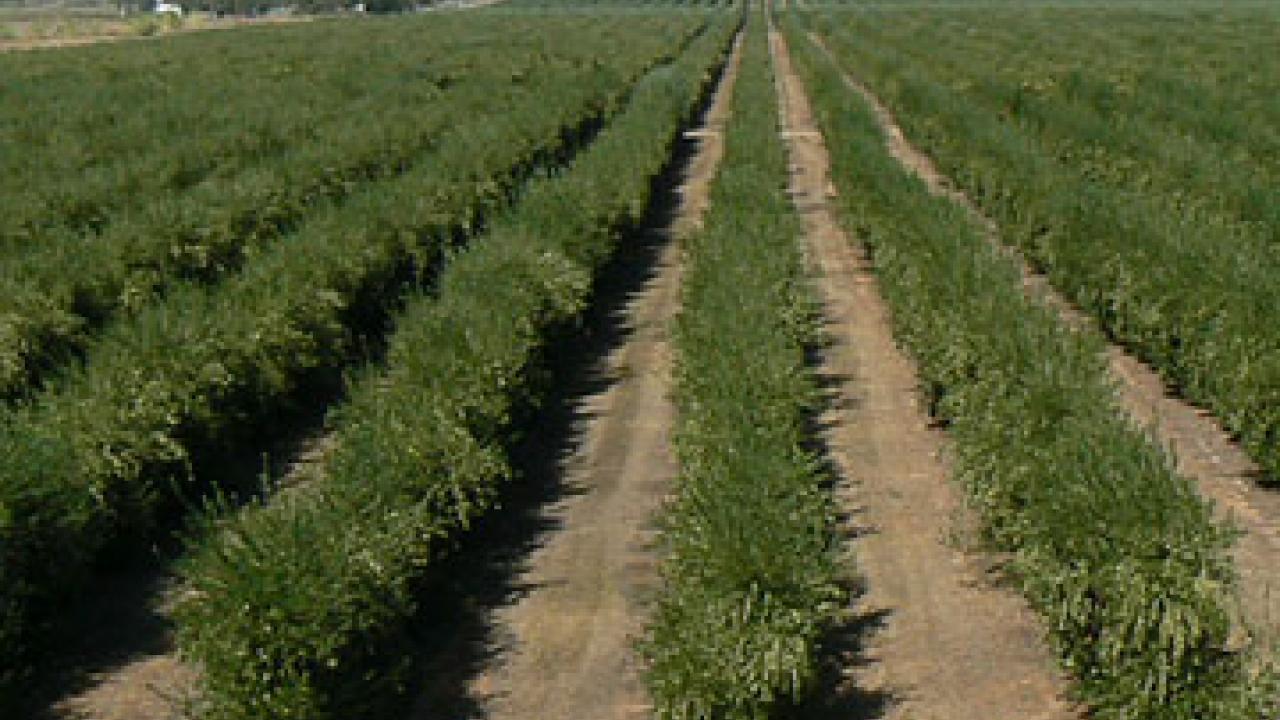A recently completed survey of California’s super-high-density olive sector, prepared by the UC Davis Olive Center, paints the picture of a young but vibrant industry, well positioned to develop olive oil into one of the state’s major agricultural commodities in the coming years.
"Super-high-density" refers to the relatively new practice of dramatically increasing the density of olive tree plantings.
“The super-high-density olive sector has achieved impressive growth in just a decade,” said Dan Flynn, executive director of the olive center. “This survey, the first conducted exclusively of this sector of the state’s olive industry, highlights grower practices and suggests areas in which the University of California might be able to provide assistance.”
In old, traditional olive production systems of the Mediterranean region, olive trees were grown in nonirrigated orchards, with trees planted as much as 60 feet apart or at a density of just 12 trees per acre. During the 1980s in Spain and Italy, the introduction of irrigation systems and improved methods of training trees enabled growers to move toward much denser plantings.
Dense planting of olive trees using such methods began in California in 1999. In just a decade, density rates in the state have increased to as high as 908 trees per acre, according to the new survey. This method of trellising olive trees eventually resembles a hedge that can be mechanically harvested, dramatically decreasing production costs.
The survey found that 12,127 acres of super-high-density olive trees were planted in California as of the end of 2008, with 78 percent of the acreage planted between 2005 and 2008. Most of the growers reported that they decided to venture into this sector because it offered “favorable income potential.” Most of the new olive plantings replaced permanent crops or row crops.
The survey, mailed to 69 super-high-density olive growers throughout California, had an 87-percent response rate. It found that Glenn and San Joaquin counties dominated the industry, in terms of planted acreage. Glenn County had 4,227 acres, or 35 percent of the state’s total super-high-density olive plantings, and San Joaquin County had 3,713 acres, or 31 percent of the total. They were followed by Butte County, with 1,128 acres of super-high-density olive orchards, or 9 percent of the total.
The survey also found that:
• The Arbequina, native to Spain, was the olive variety most commonly planted in the super-high-density system, accounting for 78 percent of the state’s acreage;
• Planting densities ranged from 453 trees per acre to 908 trees per acre, with a statewide average density of 662 trees per acre.
• 2008 was the first year of harvest for 13 percent of the responding growers, and 69 percent of the respondents had not yet harvested as of the fall of that year.
• Those growers who had harvested reported that the first day of harvest ranged between Oct. 10 and Oct. 29, median olive yield was 4 tons per acre and median olive oil yield was 40 gallons per ton.
• Almost all super-high-density growers used drip irrigation, with 64 percent of them relying on well water to irrigate their orchards, 24 percent using irrigation district water and 10 percent using surface water.
• Less than half of the respondents provided information on how much irrigation water they used. Among those who did provide information, the average annual water use for super-high-density olive plantings was 21 inches per year.
“This may be an area where University of California scientists and farm advisors can help growers calculate water usage in inches,” Flynn said.
When asked to identify particular areas of interest or concern, survey respondents mentioned that they would like to learn more about converting to or further developing organic production practices, would like to see more olive oil mills in Northern California, and would like to convert further acreage to super-high-density plantings. Moreover, some expressed a desire to discontinue super-high-density plantings but continue traditional planting methods. Others noted that they were concerned about loss of acreage due to frost.
The complete survey report, prepared by Nicole Sturzenberger, Dan Flynn, and Elizabeth Clow, is provided online by the UC Davis Olive Center at http://www.olivecenter.ucdavis.edu.
About UC Davis
For 100 years, UC Davis has engaged in teaching, research and public service that matter to California and transform the world. Located close to the state capital, UC Davis has 31,000 students, an annual research budget that exceeds $500 million, a comprehensive health system and 13 specialized research centers. The university offers interdisciplinary graduate study and more than 100 undergraduate majors in four colleges -- Agricultural and Environmental Sciences, Biological Sciences, Engineering, and Letters and Science. It also houses six professional schools -- Education, Law, Management, Medicine, Veterinary Medicine and the Betty Irene Moore School of Nursing.
Media Resources
Pat Bailey, Research news (emphasis: agricultural and nutritional sciences, and veterinary medicine), 530-219-9640, pjbailey@ucdavis.edu
Dan Flynn, UC Davis Olive Center, (530) 752-5170, jdflynn@ucdavis.edu
